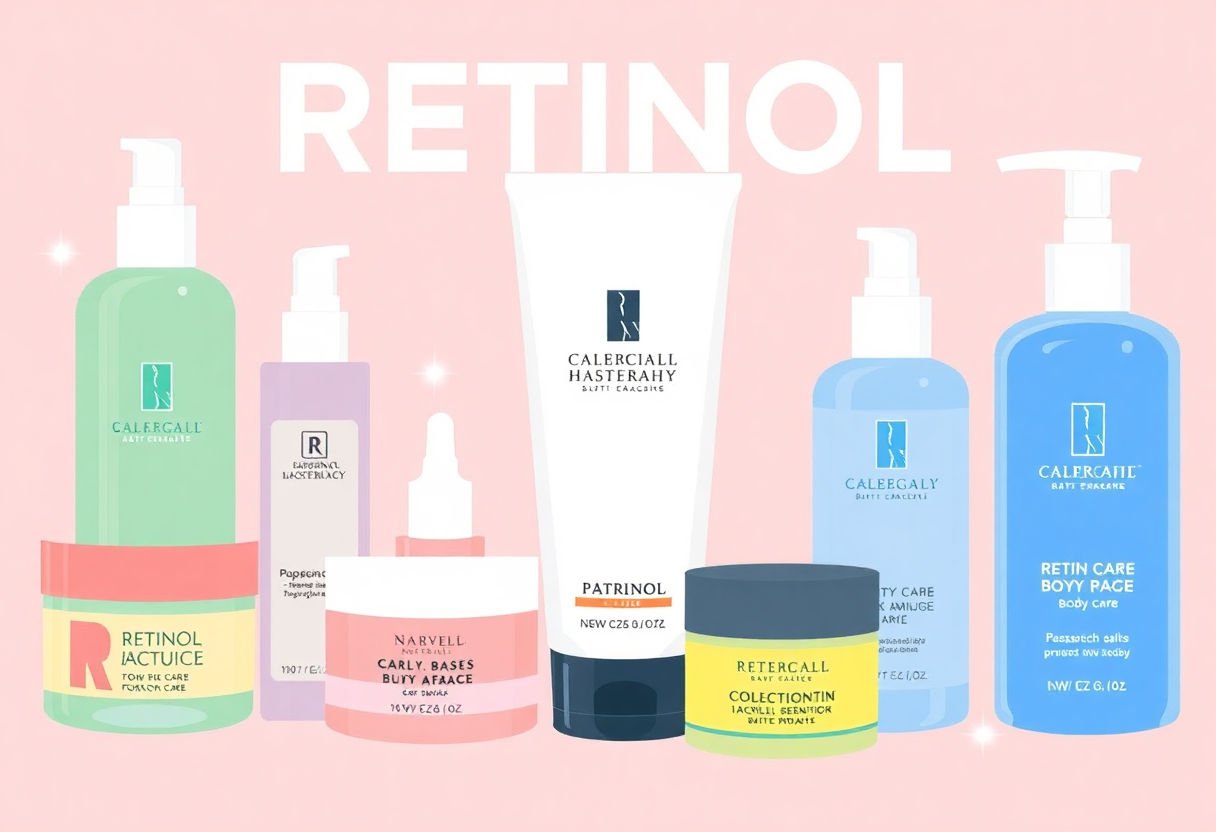Retinol, a staple in facial skincare, is now making its mark in body care routines. This guide delves into the transformative power of retinol-infused body care, exploring its benefits on skin texture and cell renewal, while offering practical advice on product selection, routine integration, and addressing potential side effects. Whether you’re a skincare novice or seasoned enthusiast, this comprehensive resource will illuminate the path to healthier, more radiant skin, unveiling the full potential of retinol for every body type. Embrace this skincare evolution and discover how retinol can become a vital part of your regimen.
Key Takeaways
-
Retinol is a powerful ingredient that extends its benefits from facial skincare into body care, aiding in skin texture improvement and promoting cell turnover.
-
Selecting the right retinol products is key to ensuring they complement your skin type and specific needs, enhancing overall efficacy.
-
Proper integration of retinol into your body care routine involves careful attention to frequency and application methods to maximize benefits and minimize side effects.
-
Understanding potential side effects and how to mitigate them is crucial for a safe and effective retinol-infused body care experience.
-
Pairing retinol with compatible active ingredients can amplify its benefits while maintaining skin health, adapting to different age-related skincare needs.
Understanding Retinol: A Brief Overview

Retinol, a derivative of Vitamin A, is a potent compound revered in the skincare industry for its remarkable effects on skin health. Originally introduced in dermatology for its role in treating acne, retinol has evolved to become a cornerstone in anti-aging skincare due to its multifaceted benefits.
Originating from the broader class of retinoids, retinol distinguishes itself by being a less intense, over-the-counter option, enabling a wider audience to experience its benefits without needing a prescription. This compound works by penetrating the skin’s outer layers and accelerating cellular turnover. By doing so, it helps to rejuvenate skin texture and tone, addressing concerns like fine lines, pigmentation, and rough patches.
Its mechanism of action involves binding to receptors in the skin, which then communicate with cells to function more effectively. This interaction leads to enhanced collagen production, contributing to firmer and more resilient skin over time. The inclusion of retinol in body care aims to extend these benefits beyond the face, targeting areas prone to sun damage, uneven texture, and age-related changes.
Despite its efficacy, it is essential to introduce retinol gradually into any skincare regimen. Achieving desired outcomes requires patience, as visible improvements typically manifest after consistent use over several weeks. By understanding retinol’s origins and its pivotal role in enhancing skin health, one can make informed decisions about integrating this powerhouse ingredient into a holistic body care routine.
Benefits of Retinol for Body Care

Retinol, a powerhouse ingredient in facial skincare, offers transformative benefits when applied to the body. Its primary advantage lies in its ability to accelerate cell turnover, rejuvenating body skin in much the same way it revitalizes facial skin. This increased rate of cell renewal helps in the reduction of hyperpigmentation and uneven skin tone, common issues for areas such as the back, chest, and shoulders.
Moreover, retinol’s role in stimulating collagen production can significantly enhance skin firmness, combating sagging and enhancing overall texture. This effect is particularly beneficial for parts of the body that naturally experience a loss of elasticity over time, such as the arms and thighs.
Another compelling reason to incorporate retinol into body care is its efficacy in tackling body acne and blemishes. By unclogging pores and reducing inflammation, retinol serves as a vital ally against persistent acne causes.
For those with rough or keratosis pilaris-prone skin, retinol proves effective. It softens and smooths rough spots often found on arms and legs, providing a silky, touchable texture. This can dramatically improve confidence and comfort in one’s skin.
Lastly, retinol works to enhance moisture retention by strengthening the skin’s natural barrier. This not only ensures hydration but also protects against environmental aggressors. However, given retinol’s potency, it is crucial to use it responsibly and in tandem with adequate sun protection. Embrace retinol for a robust, revitalized body skincare routine that delivers noticeable results.
How to Choose the Right Retinol Products
When selecting the ideal retinol products for body care, several considerations can guide you to make the best choice for your skin. Here are some essential factors to keep in mind:
-
Skin Type: Your skin type plays a crucial role in determining the right retinol product. If you have sensitive skin, opt for a product with a lower concentration of retinol (0.25% to 0.5%) to minimize the risk of irritation. Those with oily or combination skin might benefit from higher concentrations, typically ranging from 0.5% to 1%.
-
Product Formulation: Consider the overall formulation of the product. Look for additional hydrating ingredients such as hyaluronic acid and glycerin, which help to counteract retinol’s drying effects. Some formulations also include soothing agents like aloe vera or chamomile, which can further calm potential irritation.
-
Brand Reputation: Choosing products from reputable brands with a history of effective and scientifically-backed formulations is vital. These brands tend to prioritize safety and quality, offering you peace of mind with your skincare routine.
-
Your Skin Goals: Determine your specific skin goals, whether you’re aiming to reduce signs of aging, improve skin texture, or address hyperpigmentation. Selecting a retinol product that aligns with your objectives ensures that you achieve the desired results.
-
Price and Availability: While higher-end products might offer advanced formulations, there are numerous affordable options that provide excellent results. Assess your budget and product availability to choose a product that fits both your financial comfort and skincare needs.
Finding the right retinol product involves tailoring the choice to your individual skin needs and priorities, ensuring that your body’s skin receives the appropriate care and benefits from this powerful ingredient.
Incorporating Retinol into Your Routine

Integrating retinol into your body care regimen requires thoughtful planning to maximize its myriad benefits while minimizing potential irritations. Begin by selecting a retinol product specifically formulated for the body, as they often contain concentrations suited for larger skin areas.
Start Slowly: Introduce retinol gradually to allow your skin to build tolerance. Apply a small amount once or twice a week initially. Monitor your skin’s reaction carefully, noting any dryness or irritation that might occur. Adjust frequency as your skin adapts.
Timing is Key: Utilize retinol products during your evening routine. Retinol increases skin sensitivity to sunlight, so applying it at night reduces UV exposure risks. Always follow up with a broad-spectrum sunscreen during the day for added protection.
Application Method: To optimize absorption, apply retinol to clean, dry skin. After showering, lightly pat the skin dry, leaving it slightly damp to create an ideal surface for application. Use a gentle, circular motion to massage the product into your skin, ensuring even distribution.
Hydration Matters: Pair retinol with a rich moisturizer to combat any potential dryness and to bolster your skin’s hydration levels. Ingredients like hyaluronic acid or glycerin can be excellent companions, enhancing moisture retention.
Monitor and Adjust: Observe your skin’s response over a period of weeks. If irritation persists, consider reducing frequency or opting for a formulation with a lower retinol concentration. Patience is crucial as the benefits of retinol, such as improved texture and increased cell turnover, often become more pronounced over time.
Common Side Effects and How to Mitigate Them

Retinol’s transformative effects on the skin are accompanied by some common side effects that users should be aware of. These effects typically include dryness, irritation, and redness. Fortunately, there are effective ways to mitigate these issues, ensuring your retinol experience remains positive.
To combat dryness, it is crucial to maintain a robust hydration routine. Utilizing a fragrance-free moisturizer that contains ingredients like glycerin or hyaluronic acid can provide an additional barrier against moisture loss. Applying the moisturizer immediately after retinol enhances skin hydration and minimizes the likelihood of peeling.
Reducing irritation involves introducing retinol slowly into your routine. Initially, employ it once or twice a week, gradually increasing frequency as your skin acclimatizes. If redness persists, consider using a lower concentration formula. It is also wise to pair retinol use with products containing soothing elements like aloe vera or chamomile extract to calm any inflammation.
Sun sensitivity is another concern when using retinol. Retinol can heighten the skin’s sensitivity to UV rays, making the application of a broad-spectrum sunscreen with SPF 30 or higher indispensable. Consistent use of sunscreen prevents potential damage and enhances the effectiveness of retinol.
A quote from a dermatologist emphasizes the importance of patience: “With retinol, it’s a marathon, not a sprint—gradual introduction and diligent moisture can help mitigate discomfort.”
By adopting these strategies, you can enjoy the myriad benefits retinol offers to body care, armed with knowledge and preventive tactics to maintain your skin’s health and resilience.
Retinol Infused Body Care for Different Ages
Retinol is celebrated for its transformative abilities, but its effects can differ notably across various age groups. As we age, our skin’s needs evolve, and understanding these changes can maximize the benefits of retinol-infused body care.
For Your 20s: At this stage, the primary focus is often on prevention. Incorporating low-dosage retinol in body care can aid in maintaining skin’s youthful texture and tone. It acts as an early defense against emerging environmental stressors, helping to fend off long-term damage.
In Your 30s: As the skin begins to show the first signs of aging, such as fine lines and uneven texture, retinol’s reparative properties become notably beneficial. Its ability to stimulate collagen production can help counteract these early aging features. A moderate-strength retinol product applied a few times a week may be appropriate for achieving smoother and more even skin.
Entering Your 40s and Beyond: During these years, the skin experiences further decline in elasticity and hydration. Retinol serves as a critical ally in reversing these signs by enhancing cell turnover and improving moisture retention. A higher concentration of retinol may be advisable, combined with a rich moisturizer to keep the skin supple. It is crucial, however, to apply it with caution to minimize potential irritation, particularly on sensitive areas.
Adaptability is paramount; always assess your skincare regimen to ensure that it meets your skin’s evolving demands. By understanding the distinct requirements of each age group, retinol-infused body care can effectively support vibrant, healthy skin at every stage of life.
Combining Retinol with Other Active Ingredients
Retinol is a powerful ingredient on its own, but when thoughtfully combined with other active ingredients, it can create a synergistic effect that enhances its benefits for body care. Understanding these combinations is crucial to maximizing results while maintaining skin health.
Hyaluronic Acid: One of the safest and most beneficial pairings with retinol is hyaluronic acid. This ingredient is known for its exceptional hydrating properties, helping to balance the drying effects that retinol may have on the skin. With consistent use, hyaluronic acid aids in maintaining moisturized and plump skin.
Niacinamide: Combining retinol with niacinamide can significantly reduce the irritation that retinol might cause. Niacinamide is a form of Vitamin B3 that soothes the skin and enhances its barrier function. When used together, these ingredients can improve overall skin texture and even out tone, offering a more radiant appearance.
Alpha Hydroxy Acids (AHAs): For those looking to target severe hyperpigmentation or significant textural concerns, pairing retinol with AHAs can be effective. However, caution is advised, as both ingredients are potent exfoliants. It’s recommended to alternate days of use or apply them at different times of the day to minimize irritation.
Vitamin C: This combination is useful for boosting collagen production and brightening the complexion. Given that both ingredients can be potent, it’s advisable to use Vitamin C in the morning and retinol at night to exploit their full benefits without overloading the skin.
Successfully integrating these combinations into your body care routine can lead to fresher, younger-looking skin. Always conduct a patch test when introducing a new product combination and adjust based on your skin’s response.
Overcoming Myths About Retinol

One of the most pervasive myths about retinol is that it is too harsh and unsuitable for sensitive skin. While it is true that retinol can cause initial irritation, contemporary formulations often include soothing agents that mitigate adverse effects, making them accessible for a wider audience. In fact, many users find that gradual introduction of retinol yields effective results sans discomfort.
Another common misconception is that retinol should be reserved solely for facial applications. The truth is, the benefits of retinol—such as promoting cell turnover and enhancing skin texture—are equally applicable to the body. This misconception may arise from entrenched skincare routines that primarily focus on the face, inadvertently neglecting the body’s potential for rejuvenation.
It is also important to dispel the notion that retinol exclusively targets aging skin. While its anti-aging properties are celebrated, retinol also combats acne, hyperpigmentation, and uneven skin texture, proving invaluable to various skin concerns across different age groups.
Some people believe that using retinol in the daytime renders it ineffective. Although it is recommended to apply retinol at night due to its light-sensitive nature, innovations in formulation now ensure that with adequate sun protection, retinol can be safely worn during the day.
Finally, there is the fear of dependency, with aversions rooted in the myth that skin will become reliant on retinol. In reality, retinol works by enhancing the skin’s natural processes, suggesting no inherent risk of dependency. Retinol remains a potent ally in an effective body care regimen when used judiciously.
Conclusion
The transformative power of retinol-infused body care lies in its ability to enhance skin texture, promote cell turnover, and address age-related concerns more comprehensively. By integrating retinol into your skincare regimen, you embrace a scientifically backed approach to achieving healthier skin. As you select the right products and carefully incorporate them into your routine, remember the potential side effects and how to mitigate them effectively. With thoughtful application and pairing with other active ingredients, retinol can offer lasting benefits. Embrace this journey towards optimal body care and witness the remarkable improvements firsthand.
Frequently Asked Questions
What is the primary benefit of using retinol in body care products?
Retinol improves skin texture and promotes cell turnover, leading to smoother and rejuvenated skin over time. Its ability to boost collagen production can also reduce the appearance of fine lines and wrinkles.
Can everyone use retinol-infused body care products?
While retinol can benefit most skin types, individuals with sensitive skin should use it cautiously. It’s advisable to perform a patch test and consult with a dermatologist before incorporating retinol into your body care routine.
How often should retinol be applied to the body?
Retinol can initially be used once or twice a week, allowing the skin to adjust. Gradually, it can be increased to every other day, but daily use might be too harsh for some skin types.
Are there specific areas of the body where retinol should not be applied?
Retinol should generally be avoided on irritated, sunburned, or broken skin. Extra care is needed when applying to sensitive regions such as the neck and décolletage.
Can retinol be used in conjunction with other skincare ingredients?
Yes, retinol can be paired with ingredients like hyaluronic acid or niacinamide to enhance its benefits and minimize irritation. However, it’s important to avoid using retinol alongside strong acids or exfoliants in the same routine.
